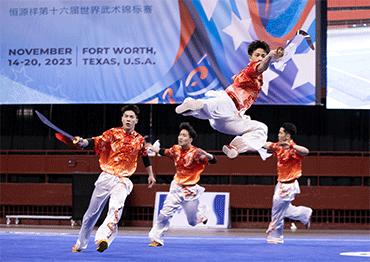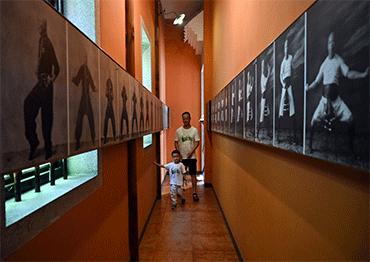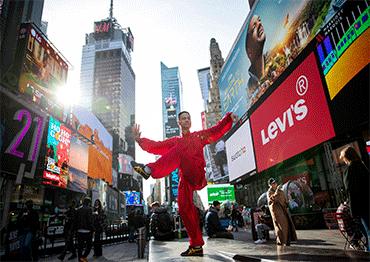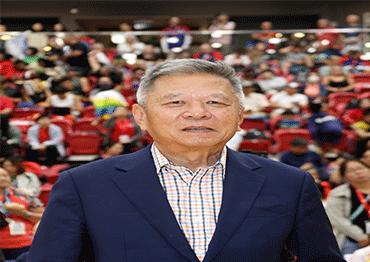hinese wushu – better known as kung fu – has long captured the imagination of the West, from Bruce Lee and Shaolin monks to Kung Fu Panda and the genre of martial arts fantasy novels known as wuxia.
Despite its immense popularity, wushu has yet to become a widespread international sport – or is widely understood as a martial art. In its competitive form, wushu integrates various forms of traditional and modern Chinese martial arts, including Shaolin kung fu and tai chi, as well as lesser-known disciplines such as the southern Chinese style of hung gar.
In an exclusive interview with China News Service (CNS) just ahead of the 16th World Wushu Championships held from November 16-20 in Fort Worth, Texas, Anthony Goh, vice president of the International Wushu Federation (IWUF), shared his insights on how to transform wushu from being a cultural icon into a popular sport embraced by a larger global community.
The biennial World Wushu Championships is hosted by the IWUF, and the 16th edition was organized by the United States of America Wushu-Kungfu Federation (USAWKF). The last time it was held in the US was 1995 in Baltimore, Maryland.
Wushu is among the four new sports included in the 2026 Dakar Youth Olympics alongside baseball, skateboarding and surfing. According to the IWUF, around 600 athletes from 52 countries and regions competed for 40 gold medals at the Fort Worth championship. The Chinese mainland ranked first with 15 medals, followed by Vietnam and China’s Macao, both with 11 medals. The US team secured nine medals, ranking 16.
A practitioner of wushu since childhood, Goh is chairman of 16th WWC Organizing Committee and president of USAWKF Board of Directors. “The United States has the greatest number of wushu talents outside of China, and as a life-long practice to promote health, one needs no language skill to learn it,” said Goh at a virtual press briefing in early November, the China Daily reported.
CNS: During your extensive tenure in promoting wushu since the first World Wushu Championships in 1991, how has wushu progressed and developed internationally?
Goh: When we first organized a wushu competition in Houston around 1986, there were about 150 participants, which was a big deal in the wushu community. In the 1990s, our competitions were already attracting thousands of participants. That’s a big change.
I have attended every world championship. When the first competition was held in 1991, the IWUF had only 38 member associations. Now it has member associations from 158 countries and regions.
Wushu’s development overseas has been closely tied to Chinese immigration – the general skill level is higher in countries with large Chinese communities. In the 1980s and 1990s, many wushu practitioners in Europe and the US came from Hong Kong and Southeast Asia. Later, more professional wushu athletes and experienced coaches came to North America and other places. As some of them were former wushu champions who retired before they went abroad, this created major changes in the overseas wushu community. These people played a key role in promoting competitive wushu. Even today, the best wushu coaches overseas are still largely first-generation Chinese immigrants. Wushu’s attractiveness and competitiveness make it something locals are willing to work on.
CNS: Many non-Chinese athletes I've encountered are strongly passionate about wushu. What makes Chinese wushu so alluring?
Goh: Wushu itself is both aggressive and expressive, which are parts of human nature. But wushu training can bring out this nature in a disciplined way, making it an attractive expression of strength and beauty.
I personally prefer the term “martial art” for Chinese wushu, because it is highly artistic. There are different wushu schools, but as a system they make the most of human biomechanics and generate an overall power through sophisticated movements, which is a pretty good art. This is how wushu works, whether it is tai chi (which looks relaxed and slow) or hung gar (which features powerful and fast moves).
What is so good about this? Young people can practice kicking, punching, grappling, and take part in fighting competitions or other events. But few Western martial arts are like Chinese wushu, where one can practice from a young age all the way up to 80 or 90 years old.
Many hung gar masters live really long lives. I think it fits what is required for health in several ways. First, it is a full-body aerobic exercise. Second, it helps train practitioners’ muscles in their upper bodies and legs. Some Chinese wushu styles are very good for one’s health, and thus worth wider promotion. Certain Chinese wushu styles are highly beneficial for overall well-being and health. Therefore, it is worthy of wider adoption and recognition.
CNS: What should be the primary focus in wushu’s overseas promotion and further globalization?
Goh: The focus should revolve around making it more accessible and easier to understand and learn. While wushu has unique characteristics and can be challenging, we can’t keep making it excessively complex. Straying too far from its essence, characteristics and traditions may hinder its growth. The International Olympic Committee (IOC) values sports for everyone, and traditional wushu is a very good example. Therefore, when promoting competitive wushu, we should also consider accessibility. There should be a balance.
If competitive wushu were to make its way into the Olympics, it needs to become more visually appealing, showcasing its gracefulness and difficulty. Compared with 30 years ago, wushu competitions require more challenging movements. Many of these new movements involve spinning the body. This is particularly challenging for non-Chinese practitioners. It takes a lot of time for them to get on par with Chinese athletes. This makes promoting wushu more challenging.
The scoring system in competitive wushu should also be simpler, which helps prevent cheating and gives practitioners and coaches clearer direction.
CNS: Efforts to promote wushu as an official Olympic sport have been going on for many years. What are the major challenges?
Goh: According to current IOC rules, the Summer Olympic program cannot exceed 28 major sports. Introducing a new sport means removing an existing one, which requires a two-thirds majority vote at an IOC Session, making it extremely difficult.
On the other hand, the IOC does allow the host country’s organizing committee to include specialty sports. For example, the Paris Olympics will feature breakdancing due to its popularity among young people. Although wushu is popular, it has yet to become mainstream.
There are still certain issues for wushu to overcome to go mainstream and become an official Olympic sport. One challenge that needs to be addressed is enhancing its visual appeal, which affects its promotion, commercial value and popularization.
While traditional wushu has achieved widespread popularity, competitive wushu still has a long way to go. After all, it has only been promoted for the past 30 years or so. Competitive wushu needs a comprehensive competition system encompassing rules, rating rules, venues and facilities. Currently, not every country and region has the capability to host a wushu event. Competitive wushu is not well developed in every country. It is not like traditional wushu, where a single coach can go and do all the promotion.
As a representative of the IWUF, I have made several presentations to the IOC for the inclusion of wushu in the Olympics. The most memorable experience was the one in St. Petersburg, Russia in 2013, when I was making a presentation to the IOC Executive Committee, and a board member asked, “What is the difference between wushu and kung fu?” We told her wushu is kung fu. The fact that an influential person like her had limited knowledge of wushu back then highlighted the limited awareness of wushu in many countries at the time. One of the factors professional organizations like the IOC take into consideration when valuing a sport is the influence of sponsors. Currently, the IWUF’s sponsors are primarily from China. The IOC definitely considers the assets and liabilities wushu brings. So we still have a long way to go.
But in my opinion, we should not regard an official Olympic inclusion as the sole or ultimate path for its development. We can make wushu a healthy and meaningful sport with broad public participation. In a bid to help wushu find its way into the Olympics, we should work to include it in more comprehensive sports events, such as the World University Games and the World Games, thus increasing its influence and reach.
CNS: What role do you think overseas Chinese can play in the promotion of wushu?
Goh: Overseas Chinese can support the sport by encouraging their children to learn wushu, which helps to promote it, or volunteering at wushu events. However, we should not support any unethical practices in traditional wushu. We should support its development into a healthy, scientific and educational sport. Overseas wushu organizations should prioritize professionalism, openness and transparency, and operate in compliance with local laws, regulations and social customs.

 Old Version
Old Version



